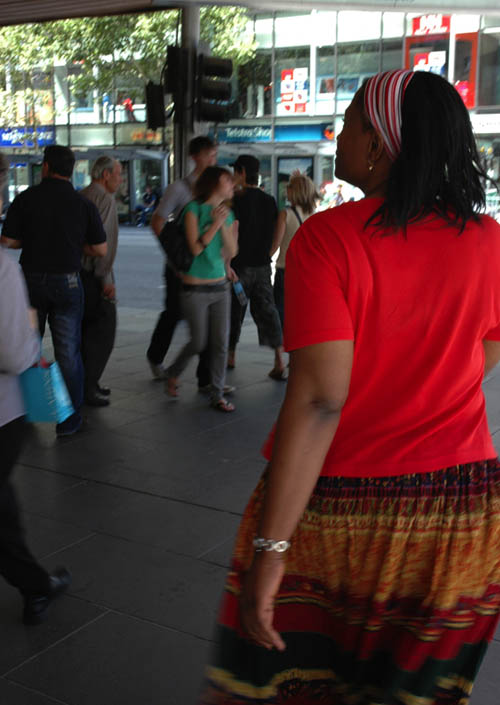2-channel binaural audio - 10minutes

Reiterations (Elizabeth Street), Sonia Leber and David Chesworth, 2-channel audio, 2006.
Description
A sound work made in the city-spaces of Melbourne, Australia. We follow a series of Africans who are now living in Melbourne, inhabiting their listening perspectives as they sing and move about the city. Our starting point is Elizabeth Street, a major transport node.
Reiterations was commissioned as part of +Plus Factors, a series of exhibitions curated by Australian Centre for Contemporary Art for the Melbourne 2006 Commonwealth Games.
Reiterations are things that are said or done again - but not always in the same way, in the same place. A reiteration can be a repetition with difference.
Voices: Mmapelo Malatji (Botswana), Habib Chanzi (Tanzania), Zweli Tlhabane (Swaziland), Carlos Panguana (Mozambique), Francess Kalon (Sierra Leone), Valanga Khoza (South Africa), Prisca Cradick (Kenya)
The following is an extract from Juliana Engberg, Artistic Director, ACCA.
´My chicken is missing´, essay for the +Plus Factors exhibition catalogue, Australian Centre for Contemporary Art, 2006 (www.accaonline.org.au/plusfactors)
´Certain sounds are unique to places. However, world cities have increasingly become a medley of sounds. A sort of acoustic mélange of everywhere and nowhere: the ambient equivalent of Marc Agué’s non-places. The same hip-hop songs hurl themselves out at you from the same chain stores, whether you are in London or LA, Changi or Moscow. The same bing-bongs announce security alerts, hot specials and transit information...
Sonia Leber and David Chesworth use this urban polyphony of sounds as a membrane through which the singular sound of the embodied voice must push and pass its way; as a kind of landscape of the generic, surrounding the story of the specific.
Leber and Chesworth’s Reiterations (Elizabeth Street) is a sampled, then produced sound-space of recorded sounds that are unmistakably urban and general: loud speakers, train horns, guitar riffs, squeaky sounds, walking, hubbub, chatter (school girls, shop keepers…), voices, car horns, throaty motorbikes...
Leber and Chesworth´s sounds are grabbed from the urban bustle of Elizabeth Street, Melbourne, a typical ‘transit’ zone of the city, with its convenience stores and Chem-marts, take-outs and mobile outlets, luggage shops and bookstores, sports retailers, pubs and hair salons. Elizabeth Street is a place of particular intersection for inter-urban travellers who use the Western, and North Western tram lines that stretch out to, and bring people in from, the suburbs of Maribyrnong, Essendon, Coburg, and Airport West. Places which, over the past few years have become the cluster suburbs for immigrants, mostly refugees, from the African countries of Zambia, Nigeria, Botswana, Tanzania, Swaziland, Mozambique, Kenya, South Africa and Sierra Leone.
Into this hub of urban noise Leber and Chesworth have sent their individual travellers to walk and sing their way through the city. Songs that once described the pulverising of corn, or the happy return of mothers from the field, or the disappearance of a chicken from the village; lullabies, love songs and laments; songs of marriage and loss enter into the urban village of Melbourne through the power of voice and breath made round and cogent in the drum of the body.
Unlike the city’s urban sounds with their artificial veneer, these African voices seem authentic and exuberant – resonant and strong. The rhythm of the voice is matched to the tempo of the walking along the street, which makes the respiration of the singer seem percussive and urgent. This sense of urgency perhaps represents the larger struggle that accompanies the condition of those caught up in the diaspora, and the reserve of strength it takes to enter a new place and space while keeping a cultural memory and life intact...
These are grounded, earthy voices with feet and legs, and arms and bodies, and chests with air pumping. These are private voices made public. For most people music is generally internalised, either in their memory repertoire, or from their iPods, to assist them to individuate amidst the generalised, conglomerated experience of life in the fast lane.